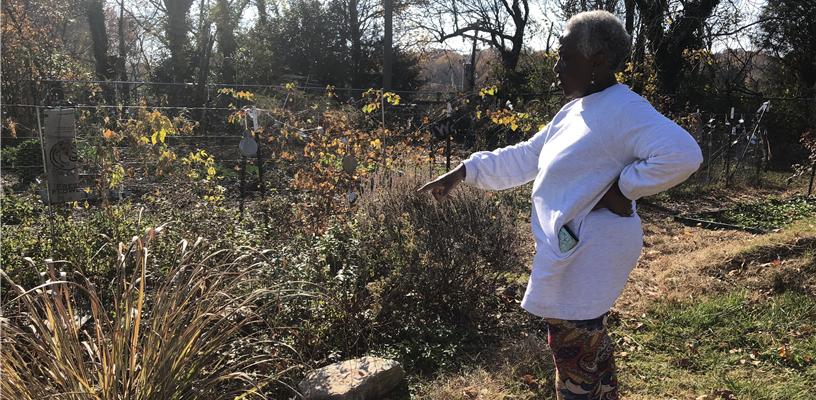
- By Jeffrey Cates
- Posted Monday, November 29, 2021
Irma Jackson - Community Gardener
In the warmth of the early afternoon of November, Irma Jackson is seated on a cast iron bench. We’re looking over her school garden at Diggs Latham Elementary school in West Salem. Behind us we can hear children running, laughing and kicking a soccer ball. The stand of frost bitten herbs and the carpet of vibrant maple leaves reveal a garden in slumber, but Irma’s story is full of life.
What is your earliest memory of working in a garden?
“My grandmother had a garden, chickens and blackberry bushes. I was the youngest and shortest to the ground”. I asked if she remembers weeding as a child. “No, I remember dropping seeds into the ground.”
In the unconventional classroom of the garden, who has been your mentor?
Irma recalled longing for a garden of her own. She doesn’t recall a specific mentor but named Derek Morris, NC Cooperative Extension Horticulture Technician as a good friend. “He’s always been a good person to talk to and a source of knowledge.”
Diligently, Irma encouraged her grandchildren to save their seeds and to plant them. “My grandson took me literally and planted mystery seeds in a brick planter behind my house. They did peek out the ground and rambled down the side of the house. Gourds. They were gourd seeds.”
What led you to serve in this specific community garden?
She corrected me, “You mean what led me to this space.”
Irma was the founder of the Diggs Latham Elementary Garden. At the time her grandson was in the 4th grade at Diggs Latham. Mary Jac, NC Cooperative Extension Agent, was a friend and she asked Irma to consider being a community gardener. The invitation appealed to Irma because she wanted the children to know how to recognize carrots, to tell the difference between lettuce and greens. “Children should know that not every ruffled leaf is lettuce.” Giving children the knowledge of the source of their food and even plant taxonomy was motivational to Irma. She taught science at Parkland High School for 30 years and in her retirement she wanted to continue that mission of education.
What is it about this space that gives you joy?
“Being engaged.” In caring for this school garden, Irma has received the collaboration and investment of her community. Wake Forest University’s Nathan Peifer has brought students to serve in this space for one growing season thus far. WFU even wrote a custom grant to support the garden. Originally, she had a wooden pallet fence. An artist friend, Carol Eickmeyer, encouraged her to replace it with a see-through wire fence. “The children have to see the garden first, before they will want to come into the garden.” The local community garden club sponsored her new fence.
How does this space fuel the learning that takes place in the school?
Irma’s vision was that this garden was not to feed stomachs, but a place of entertainment, of feeding the mind. “Gardens are not just for food. I sought out green cotton seeds and planted some in the garden. Then I invited a weaver to come and demonstrate the process of turning cotton bolls into fabric. This green cotton has a green tinge down in the boll that cannot be washed out,” Irma said with a laugh. Diggs Latham also has a science coordinator, Ms. Mikki Wynn who uses the garden space to broaden the school’s curriculum.
Would you share a story about one student with whom you had a moment of epiphany?
During the pandemic, most of the students were studying from home. Irma pointed over her shoulder to the corner of the school and said the pre-K and Kindergarten students were onsite last year. Their teacher asked her, “Can our children plant something?” Irma replied, “Radishes fit the bill. On the last day of school, their harvest was ready.”
Gardening is both an art and a science. This is one of Nathan Peifer’s quotes that I love. How have you seen those two subjects overlap in your experiences in the garden?
Irma’s layout of the garden is not in boxes or rows. She designed her plot strategy to draw people and pollinators into the garden. Flowers are in the center of the garden. “No two people will design their garden the same,” said Irma.
How does your role as a garden hero help to connect you with your community?
“I don’t see myself as a hero. I am a gardener, period. I am fulfilled when past students recognize me and remember what I taught them. Many of them didn’t see the value of what I was teaching them at the time, but the value is revealed later in their lives,” replied Irma.
What do you hope as you look into the future for this garden?
“I hope that someday, somebody will take over for me, someone with a love for plants,” replied Irma.
Children have an innate sense of play. How have you seen them bring play into the garden?
“The classroom can be a place that is hard for some children to concentrate, to be still. A child who is disruptive in the classroom can come to the garden and here he can become the leader. The garden is a place of dynamic teaching,” shared Irma.
We arose from the benches and Irma began the buffet. First she offered stevia leaf, then mint. We looked over the garden fence. It’s a wide rectangle. Even now I can recognize flowers along the edges, inside and out. A tall willowy tuft of asparagus sways gently in the breeze. Irma opened the gate and invited me to follow her along the path, bordered by spearmint. As we walked she pinched off pieces from her beds for an impromptu salad: arugula, raspberries, goji berries, and chocolate mint.
There’s a groundhog and birds who steal unwelcome bites from her garden, but there’s a solid fence and a host of scarecrows and shiny circles to keep them at bay. Even in this sleepy time in the garden, Irma has woody plants and perennials primed to yield in the spring: asparagus, pawpaw trees and blackberry bushes.
One last image I would like to leave with you is Irma’s hands: gentle, strong and generous. As we headed back towards the gate, she paused in front of a hibiscus bush, aka Jamaican sorrel, and pulled off several blooms. Into my hand she placed them and said, “A gift for you. Pull off the petals and pour boiling water over them for a nourishing tea.” So here I sit, writing and sipping hibiscus tea, remembering the unconventional classroom of Irma Jackson. She is a good teacher.










